The 1951 Ford F2, a robust and iconic American workhorse, emerged from the post-war era as a symbol of American ingenuity and industrial might. This truck, with its distinctive design and powerful engine, played a crucial role in rebuilding the nation and reshaping the landscape of transportation.
It was a versatile vehicle that served farmers, builders, and businesses alike, becoming a staple on roads and construction sites across the country. The F2’s enduring legacy lies not only in its functionality but also in its cultural impact, influencing the design and perception of trucks for generations to come.
The 1951 Ford F2 boasted a sturdy, all-steel cab, a powerful flathead V8 engine, and a robust frame designed to handle heavy loads. Its design incorporated several innovations, including a new suspension system and a more efficient braking system. The F2’s versatility was further enhanced by its availability in various configurations, ranging from single-axle pickups to heavy-duty dump trucks.
Its robust construction and powerful engine made it an ideal choice for a wide range of applications, from hauling farm supplies to transporting construction materials.
The 1951 Ford F2
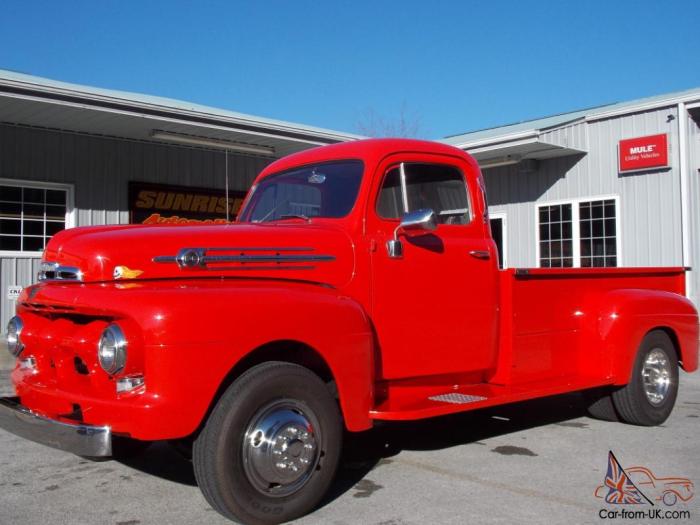
The 1951 Ford F2 marked a significant milestone in the evolution of Ford’s truck lineup. Introduced in the wake of World War II, this robust workhorse played a crucial role in rebuilding America and establishing Ford as a leading force in the commercial vehicle market.
Design and Features
The 1951 Ford F2 showcased a distinctive design that embodied the spirit of the era. Its rugged, boxy silhouette, with its distinctive “split” grille, was a hallmark of the post-war era. The F2’s design prioritized functionality and durability, reflecting its intended role as a reliable workhorse.
The F2 offered a range of engine options, including the powerful 239 cubic-inch flathead V8 engine. This engine, renowned for its durability and power, was a key contributor to the F2’s reputation for strength and performance. The F2 was available in various configurations, including a variety of cab styles, wheelbases, and cargo bed options, catering to the diverse needs of its intended users.
Historical Context
The 1951 Ford F2 emerged into a rapidly evolving post-war landscape. The American economy was experiencing a period of unprecedented growth, fueled by a surge in consumer demand and government investment in infrastructure. This economic boom created a high demand for trucks, which played a vital role in transporting goods, materials, and people across the country.
The F2’s introduction coincided with the rise of the American trucking industry. The need for reliable and efficient trucks to move goods across expanding highways and bustling cities fueled the growth of trucking companies and spurred innovation in truck design.
The F2, with its robust build and dependable performance, became a mainstay in this burgeoning industry.
Significance in the Evolution of Ford Trucks
The 1951 Ford F2 represented a crucial step in the evolution of Ford’s truck lineup. It built upon the success of its predecessors while introducing innovative features and design elements that would become hallmarks of future Ford trucks. The F2’s emphasis on durability, reliability, and performance established a foundation for the success of the F-Series, which would later become the best-selling truck in American history.
The F2’s design elements, such as the split grille and the robust frame, were refined and incorporated into subsequent Ford truck models, evolving alongside the changing needs of the trucking industry. The F2’s success solidified Ford’s position as a leader in the commercial vehicle market, laying the groundwork for the company’s enduring legacy in the truck segment.
Design and Engineering of the 1951 Ford F2
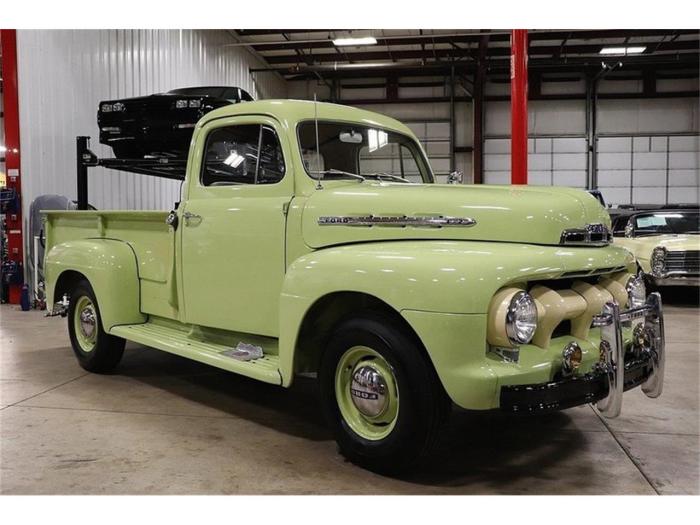
The 1951 Ford F2 was a significant step forward in truck design and engineering, building upon the foundation laid by its predecessors. This truck, while retaining the ruggedness and practicality of earlier models, incorporated new features and advancements that improved performance, efficiency, and driver comfort.
Engine and Transmission
The 1951 Ford F2 was powered by a 239 cubic inch (3.9L) inline six-cylinder engine. This engine, known as the “Flathead Six,” produced 95 horsepower and 160 lb-ft of torque. It was a reliable and durable engine, known for its smooth operation and strong low-end torque, making it well-suited for hauling heavy loads.
The engine was paired with a three-speed manual transmission, which provided adequate power delivery for the truck’s intended applications.
Suspension and Braking
The F2 featured a sturdy suspension system designed for heavy-duty use. The front suspension consisted of a solid axle with leaf springs, while the rear suspension used a similar setup with a heavier-duty leaf spring arrangement. This setup provided a robust platform for carrying heavy loads and navigating rough terrain.
The braking system utilized hydraulic drum brakes on all four wheels, providing reliable stopping power for the truck.
Cab and Body
The 1951 Ford F2’s cab was spacious and comfortable for its time. It featured a bench seat that could accommodate two people, and the dashboard was functional and easy to use. The truck was available in various body styles, including a regular cab pickup, a stake bed, and a flatbed.
The 1951 Ford F2, a workhorse of its time, was a significant step forward in the evolution of Ford’s truck lineup. While it retained some of the classic styling cues of its predecessors, it also incorporated new features like a more powerful engine and a redesigned cab.
This evolution can be traced back to the earlier 1937 Ford F-Series , which introduced the iconic F-Series nameplate and set the foundation for the trucks that would come to define American automotive history. The 1951 F2, with its sturdy construction and reliable performance, continued to build on this legacy, solidifying Ford’s position as a leading truck manufacturer.
The bodywork was sturdy and well-constructed, designed to withstand the rigors of heavy-duty use.
Design Advancements
The 1951 Ford F2 incorporated several design advancements that set it apart from its predecessors. One notable feature was the use of a more aerodynamic front end, which helped to improve fuel efficiency. The truck also featured a more modern and streamlined design, giving it a more appealing aesthetic compared to earlier models.
The F2 also featured a wider grille, which improved engine cooling, and a more spacious cab, enhancing driver comfort.
Comparison to Contemporaries
The 1951 Ford F2 competed with other popular trucks of its time, such as the Chevrolet Advance-Design and the Dodge B-Series. While all three trucks offered similar features and capabilities, the Ford F2 was generally considered to be a more robust and reliable truck.
Its powerful engine, sturdy suspension, and spacious cab made it a popular choice among commercial operators.
The 1951 Ford F2 in Popular Culture
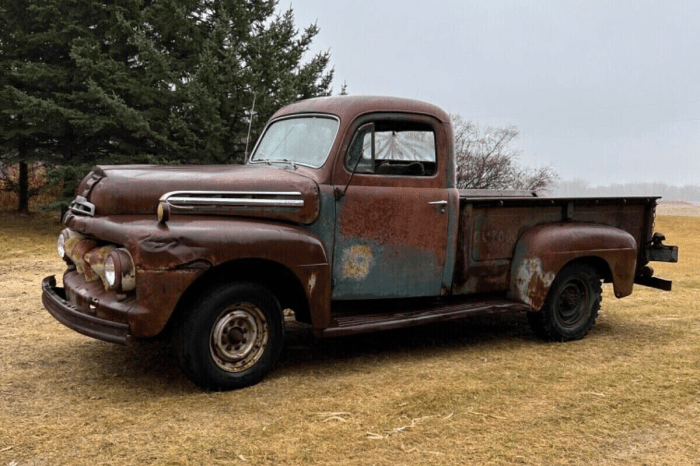
The 1951 Ford F2, a workhorse of its time, has left its mark not only on the automotive landscape but also on popular culture. Its enduring appeal is evident in its appearances in various forms of media, where it has often been portrayed as a symbol of American ingenuity, hard work, and resilience.
This section delves into the cultural impact of the 1951 Ford F2, exploring its presence in movies, television shows, and literature, and analyzing the messages conveyed through these representations.
The 1951 Ford F2, a workhorse of its time, marked a significant shift in Ford’s truck lineup. While the F2 offered rugged utility, its predecessor, the 1940 Ford Tudor , represented a different era, focusing on elegance and affordability.
Both vehicles, however, played a vital role in shaping Ford’s legacy and the American automotive landscape.
Appearances in Popular Culture
The 1951 Ford F2’s enduring appeal is reflected in its appearances in various forms of media. Its rugged design and historical significance have made it a popular choice for filmmakers and writers seeking to capture a specific time period or evoke a sense of Americana.
Here are some notable examples:
- Film:The 1951 Ford F2 has been featured in several films, often as a backdrop for stories set in the 1950s. For instance, in the classic Western film “The Searchers” (1956), a 1951 Ford F2 is prominently featured, transporting the main characters across the vast landscapes of the American West.
This use of the vehicle adds to the film’s authenticity and reinforces its themes of adventure and exploration.
- Television:The 1951 Ford F2 has also made appearances on television, particularly in period dramas and historical documentaries. In the popular series “Mad Men” (2007-2015), a 1951 Ford F2 is often seen transporting the characters around the bustling city of New York, reflecting the era’s changing social and economic landscape.
This portrayal highlights the vehicle’s role as a symbol of progress and mobility in post-war America.
- Literature:The 1951 Ford F2 has also found its way into literature, often serving as a symbolic representation of a particular time and place. In the novel “The Grapes of Wrath” (1939) by John Steinbeck, a 1951 Ford F2 is used by the Joad family as they migrate westward during the Dust Bowl era.
The vehicle becomes a symbol of their resilience and determination in the face of adversity, reflecting the hardships faced by many Americans during this period.
Collecting and Restoring the 1951 Ford F2
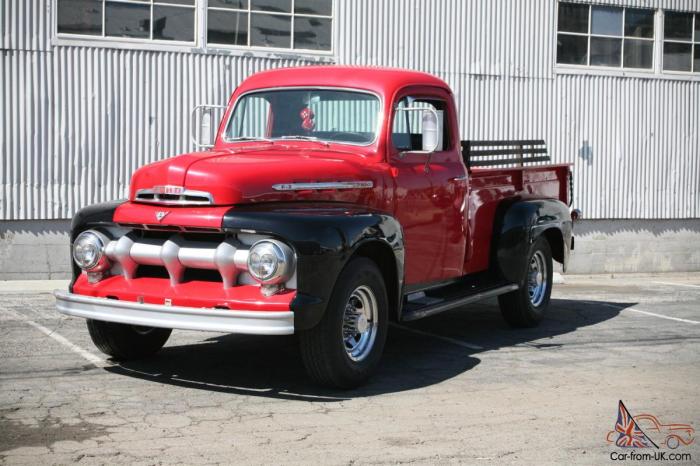
The 1951 Ford F2, a classic workhorse of its time, continues to capture the hearts of collectors and enthusiasts. Restoring these trucks to their former glory is a rewarding endeavor, requiring dedication, knowledge, and access to the right resources.
Types of 1951 Ford F2 Models and Their Value
The 1951 Ford F2 was available in a range of configurations, catering to diverse needs.
The 1951 Ford F2 marked a significant step in the evolution of Ford’s truck lineup, introducing a more robust and powerful design. While the F2 focused on workhorse utility, enthusiasts often look back to the stylish elegance of earlier models like the 1931 Ford 5-Window Coupe , a classic that epitomized the Art Deco era.
The F2, however, continued to solidify Ford’s reputation for building reliable and dependable trucks, setting the stage for the iconic F-Series we know today.
- Cab Styles:The F2 was offered with a standard cab and a deluxe cab, with the latter featuring more luxurious appointments.
- Bed Lengths:Bed lengths varied, with 8-foot and 12-foot options being the most common.
- Engine Options:The 1951 F2 was powered by a 239 cubic inch flathead V8 engine, delivering 100 horsepower.
- Transmissions:A three-speed manual transmission was standard, while a four-speed manual was optional.
The rarity and value of a 1951 Ford F2 depend on its condition, originality, and specific features. Well-preserved and original examples are highly sought after by collectors, often fetching significant prices at auctions and private sales.
Identifying Genuine Parts and Components, 1951 Ford F2
Authenticity is crucial for any restoration project. Identifying genuine 1951 Ford F2 parts is essential for maintaining the vehicle’s integrity and value.
- Part Numbers:Ford used a specific numbering system for its parts. Checking part numbers against original Ford documentation can help verify authenticity.
- Casting Marks:Original Ford parts often bear casting marks, including the Ford logo, date codes, and foundry markings. These marks can help distinguish genuine parts from aftermarket replicas.
- Materials:Original parts were made from specific materials, such as cast iron, steel, and brass. Inspecting the materials can provide clues about a part’s authenticity.
Resources for Restoration
Restoring a 1951 Ford F2 requires a wealth of information and resources.
- Online Forums and Communities:Online forums and communities dedicated to classic Ford trucks offer a wealth of information, technical advice, and parts resources.
- Restoration Manuals and Books:Specialized restoration manuals and books provide detailed instructions, diagrams, and technical specifications for restoring a 1951 Ford F2.
- Specialty Parts Suppliers:Numerous specialty parts suppliers specialize in providing genuine and reproduction parts for classic Ford trucks.
- Vintage Ford Clubs:Joining a vintage Ford club can connect you with experienced restorers, parts suppliers, and a network of fellow enthusiasts.
The Legacy of the 1951 Ford F2
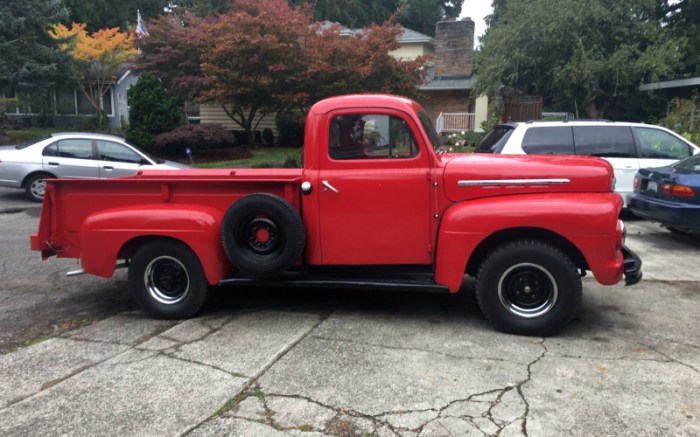
The 1951 Ford F2, while not as widely celebrated as its later successors, played a crucial role in shaping the future of Ford trucks and the automotive industry as a whole. It was a testament to Ford’s commitment to innovation and its understanding of the evolving needs of its customers.
The F2’s robust design, powerful engine, and versatile capabilities set a precedent for future generations of Ford trucks, laying the foundation for the iconic F-Series we know today.
The 1951 Ford F2’s Impact on the Automotive Industry
The 1951 Ford F2’s introduction marked a significant shift in the automotive landscape. Its robust design and powerful engine made it a workhorse for various industries, including construction, agriculture, and transportation. This versatility propelled the demand for trucks and contributed to the growth of the commercial vehicle market.
The F2’s success also inspired other manufacturers to develop similar trucks, further fueling the evolution of the truck segment.
Epilogue: 1951 Ford F2
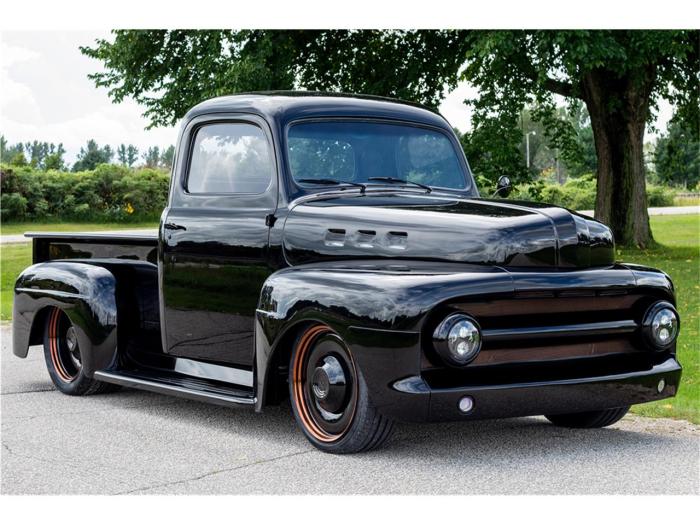
The 1951 Ford F2 remains a beloved classic, cherished by collectors and enthusiasts for its timeless design and historical significance. Its impact on the automotive industry is undeniable, paving the way for future generations of Ford trucks and influencing the design and functionality of work trucks worldwide.
Today, the F2 stands as a testament to American ingenuity and the enduring power of classic design, reminding us of the vehicles that shaped our nation’s history and continue to inspire generations of truck lovers.